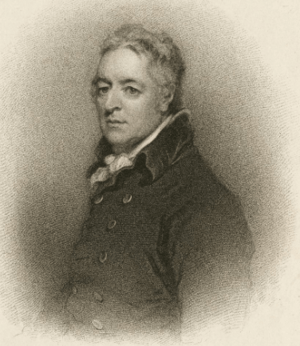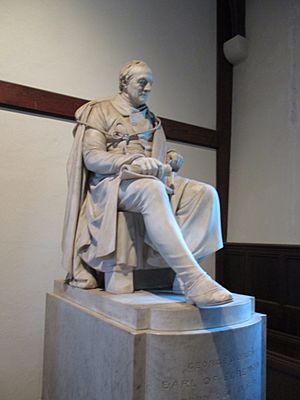George Wyndham, 3rd Earl of Egremont facts for kids
Quick facts for kids
George Wyndham
|
|
|---|---|
| 3rd Earl of Egremont | |

|
|
| Born | 18 December 1751 Petworth House, Sussex, England |
| Died | 11 November 1837 (aged 85) Petworth House, West Sussex |
| Spouse(s) |
Elizabeth Ilive
(m. 1801) |
| Issue | 40+ illegitimate children, including: George Wyndham, 1st Baron Leconfield General Sir Henry Wyndham |
| Father | Charles Wyndham, 2nd Earl of Egremont |
| Mother | Hon. Alicia Maria Carpenter |
| Occupation | agriculturist |
George O'Brien Wyndham, 3rd Earl of Egremont (born December 18, 1751 – died November 11, 1837) was an important British nobleman. He lived at Petworth House in Sussex and Orchard Wyndham in Somerset. He owned a lot of land and was a famous art collector.
He was very interested in new scientific ideas and farming. He was a friend of the farming writer Arthur Young. The Earl also loved building canals and invested in many projects. These projects helped improve his large estates. He played a small part in politics.
George Wyndham was a great supporter of artists. The famous painter J. M. W. Turner even lived at Petworth House for a while. Other artists like John Constable and George Romney also received work from him. He filled his home with many valuable artworks. The Earl also helped with the Petworth Emigration Scheme. This plan helped people move to new lands to escape poverty. He was known for being kind, generous, and a bit unusual. Many people said he was very rich and shared his wealth freely.
The Earl had many children, but only one legitimate child who died very young. Because of this, his nephew, George Wyndham, 4th Earl of Egremont, became the next Earl. However, George Wyndham left his main estates, including Petworth House, to his eldest son, George Wyndham, 1st Baron Leconfield.
Contents
Early Life and Inheritance
George Wyndham was born on December 18, 1751. He was the oldest son of Charles Wyndham, 2nd Earl of Egremont. His mother was Alicia Maria Carpenter.
In 1763, when he was just 12 years old, he became the Earl of Egremont. He inherited his father's titles and large estates. These included lands in Sussex, Cumbria, Wiltshire, and Somerset. The Somerset estate, Orchard Wyndham, had been in his family for a very long time. He later also inherited lands in Ireland.
He went to school at Wandsworth and Westminster School. In 1774, he added "O'Brien" to his name. This was after he inherited more land in Ireland from his uncle. He also traveled to Italy twice in the 1770s. These trips were part of a "grand tour," a common journey for young noblemen. In London, he spent time with fashionable young men of his time.
Supporter of the Arts
The Earl of Egremont was a big supporter of artists. He helped painters like Turner and Constable. He also supported the sculptor John Flaxman. Flaxman created a large sculpture for Petworth House.
Turner spent a lot of time at Petworth House and had his own studio there. He painted many landscapes of the area. These included scenes of Petworth, Arundel, and even one of the Earl's canal projects. Like his father, the Earl also collected French furniture. He bought beautiful items during a trip to Paris in 1802.
Building Canals
The Earl was very keen on building canals. Canals helped improve his Petworth estates. They allowed chalk to be brought in for farming. They also brought coal, which replaced wood for fuel. This meant more land could be used to grow food.
His first canal project was the Rother Navigation. This made the River Rother easy to travel on up to Midhurst. When he couldn't find a good builder, his own workers did most of the work. The canal reached Petworth in 1795 and Midhurst in 1796. A branch canal, the Petworth Canal, was also built.
In 1796, the Earl bought many shares in the Arun Navigation Company. He saved it from financial trouble. He wanted to connect the River Arun to the River Wey in Surrey. This would create an inland waterway from London to Portsmouth. This route would be safer from storms and attacks. The Wey and Arun Junction Canal was finished in 1816. In 1823, the Portsmouth and Arundel Canal was completed. This included the Chichester Ship Canal. This finished the London to Portsmouth route for barges.
Several boats were named Egremont. These included a barge and a ship built for coastal trade. Later, a steam tug also carried the name.
Helping People Emigrate
In the early 1800s, there was a risk of famine due to wars and population growth. It was important to grow as much food as possible. In the 1820s, moving to new countries, mostly Canada, was encouraged. This helped reduce unemployment and poverty in the countryside.
Thomas Sockett, a local church leader and friend of the Earl, started the Petworth Emigration Scheme. Between 1832 and 1837, this scheme sent 1,800 people to Upper Canada. The Earl encouraged people on his land to join. He offered to pay the cost of their journey, which was £10 per person.
Improvements in Agriculture
The Reverend Arthur Young, a farming expert, visited Petworth House. The Earl created a special herd of Sussex cattle. Young praised these cows as "among the best of the kingdom." A herd of these cows still lives at Stag Park today. The Earl also kept other types of cattle and sheep. He even tried exotic Tibetan Shaul goats for their fine wool.
He created Stag Park model farm on his estate. This land was cleared and drained. It allowed more food to be grown instead of wood. New ways of growing crops were introduced. Potatoes and rhubarb were also grown at Petworth.
The Earl also improved his large estates in Yorkshire. He spent a lot of money on drainage and fencing there. He also bred horses and used new farm machines. He even continued to use oxen for farm work, even when others stopped.
John Ellman, a writer, praised the Earl's efforts with horses. He noted that the Earl let local farmers use his valuable horses for breeding. He also gave prizes for the best young horses at a local fair.
In 1800, the Earl bought land at Houghton, Sussex. He developed chalk pits there. This chalk was used to improve soil for farming. A canal was dug to move the chalk by barge to other parts of the river system.
Other Projects
The Earl also supported other businesses. Paper mills were set up near Petworth. A government factory was built to make high-quality charcoal. This charcoal was used for making gunpowder.
In North Yorkshire, the Earl hired a geologist named William Smith. Smith searched for coal and iron ore. Money was invested in digging test wells. However, not enough coal was found to be useful for business.
Horse Racing Interests
George Wyndham had a horse racing stable near Lewes. His first winning horse raced in 1777. His horse Assassin won the Derby in 1782. This was the first of his five Derby winners. He also had five winners at the Oaks race. His racing colors were dark green with a black cap.
Involvement in Politics
The Earl of Egremont was a member of the Whig party. In 1787, he bought the "pocket borough" of Midhurst. This meant he could choose who represented Midhurst in Parliament. He used it to send his two younger brothers to the House of Commons.
When the Whig party split over the French Revolution, he supported Prime Minister William Pitt the Younger. He disagreed with the harsh Poor Law Amendment Act of 1832. This law created the difficult workhouse system. He believed it was a very bad idea.
His secretary, Thomas Sockett, was very involved in helping the poor. Sockett also managed the Petworth Emigration Scheme. He had disagreements with government officials about these issues. The national newspapers reported on these disputes.
Military Role
In 1794, the local volunteer cavalry, called the Yeomanry, was restarted. This was to prepare for possible invasion or unrest after the French Revolution. These forces were led by important landowners. In Sussex, the Earl himself was the Colonel. He also commanded the Petworth Troop. Volunteers provided their own horses. The government paid for their upkeep and basic equipment. The Earl bought extra weapons and uniforms. By 1798, the Petworth Troop had 52 members.
Improvements in Petworth Town
The Earl paid for a new market house in Petworth in 1793. This was built in the market square. Before, cruel practices like bull-baiting happened there. The Earl stopped these practices. He also stopped the cruel game of "throwing at cocks." The new Market House was made of stone.
In 1784, the Earl provided land for a new House of Correction. This replaced an old, dirty jail. The new building had 32 cells. Prisoners were kept alone and were not allowed to talk to each other. Even in the chapel, they were in separate boxes.
Town gas was brought to Petworth in 1836. A gas works was built, using coal brought by barge. A monument stands in Petworth today. It was given by the townspeople to thank the Earl.
The Earl bought a spire for St Mary's Church from Brighton. It later became crooked and was removed in 1947. The great wall he built around Petworth Park is still there today. It is made of sandstone, over two meters tall, and about fourteen miles long. It divides the park into different areas. A private road also ran through the park. This road allowed the Earl and his friends to avoid a toll gate.
Family and Succession
The Earl married Elizabeth Ilive in 1801. They had one child, a daughter named Elizabeth, who sadly died as a baby. After this, Elizabeth Ilive moved to London.
Since the Earl had no surviving legitimate child, his nephew, George Francis Wyndham, 4th Earl of Egremont, became the next Earl. The Earldom of Egremont ended when his nephew died without children. The main estates, including Petworth, went to Colonel George Wyndham, the Earl's eldest natural son. He later became Baron Leconfield. Another son, Henry Wyndham, inherited family lands in Cumberland.
Death
The Earl died at Petworth House on November 11, 1837. One of his last public appearances was at a horse fair in Egdean. The Earl offered a £20 prize for the best young horse there.
Images for kids







